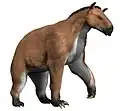| Anisodon Temporal range: Late Miocene | |
|---|---|
 | |
| Restoration | |
| Scientific classification | |
| Domain: | Eukaryota |
| Kingdom: | Animalia |
| Phylum: | Chordata |
| Class: | Mammalia |
| Order: | Perissodactyla |
| Family: | †Chalicotheriidae |
| Subfamily: | †Chalicotheriinae |
| Genus: | †Anisodon Lartet, 1851[1] |
| Type species | |
| †Anisodon grande de Blainville, 1849 | |
| Species | |
| |
Anisodon (Greek: "unequal" (anisos), "teeth" (odontes)[2]) is an extinct genus of chalicothere that lived in Europe during the late Miocene. It stood at about 150 cm and weighed around 600 kg. It is thought that the animal's clawed forelimbs would have allowed it to pull down tree branches in order to browse, as well as deter Miocene predators such as bear-dogs and saber-toothed cats.

Foot bones

Models in Basel
References
- ↑ "Anisodon". Fossilworks.
- ↑ "Glossary. American Museum of Natural History". Archived from the original on 20 November 2021.
Further reading
- McKenna, Malcolm C.; Bell, Susan K. Classification of Mammals. p. 149.
- Lydekker, Richard. "Part 3. Containing the Order Ungulata, Suborders Perissodactyla, Toxodontia, Condylarthra, and Amblypoda". Catalogue of the Fossil Mammalia in the British Museum (Natural History). p. 162.
This article is issued from Wikipedia. The text is licensed under Creative Commons - Attribution - Sharealike. Additional terms may apply for the media files.
